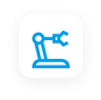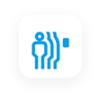Robotics is an interdisciplinary branch of study that derives from Engineering and Computer Science. This field helps us to develop machines such as robots that can replace humans and emulate human actions. On the other hand, autonomous robotics incorporate Artificial Intelligence (AI) and computer vision technology, helping us design, and develop robots that can operate and perform tasks without human intervention.
So, with the advent of autonomous robotics, robots are no longer science fiction. These intelligent robots, like humans, can make decisions upon perceiving environmental conditions and act accordingly. In addition, autonomous robots can take up tedious and dangerous tasks and divert the human workforce towards more interesting yet value-creating tasks.
The size of the international market of Autonomous Mobile Robots (AMR) was around $2.4 billion in 2021. The market size is expected to exceed $10 billion by 2028 at a Compound Annual Growth Rate (CAGR) of nearly 23 percent. This article discusses the future of autonomous robotics in some prominent areas, such as boats, cars, and inspection vehicles.
Boats
Self-steering boats are becoming a reality with the aid of autonomous robotics. For example, in April last year, Yara Birkeland, considered the world's first electric yet autonomous container vessel, entered maritime services in Norway. Similarly, a commercial tanker christened Prism Courage recently sailed through the Panama Canal from Texas to South Korea. The ship was guided by a software named Avikus developed by the shipbuilding operation subsidiary of HD Hyundai.
These smart boats powered by AI are getting ready to transport people across oceans, rivers, and lakes in various parts of the globe. In addition, these Robo-boats make us easily sail through the world's waterways and leave fewer carbon footprints than crewed ships or boats.
Cars
Autonomous robotics has long been associated with self-driving cars, but it wouldn’t be the case in the future. Autonomous robotics will transform current automotive manufacturing. Moreover, the current linear, static, and capital-intensive factory production approaches will never work in the future. Autonomous robotic solutions help transform factories and their production lines, enabling them to embrace flexible production processes. This is a giant leap toward the future of smart factories and Industry 4.0.
Lightweight autonomous robots like Autonomous Guided Vehicles (AGVs) and Autonomous Mobile Robots (AMRs) can easily collaborate with humans and move freely in the factories, eliminating the dependence on traditional factory production lines in the future.
Inspection Vehicles
The Maintenance, Repair, and Overhaul (MRO) industry must always meet the challenges of dangerous working conditions, lack of unmanned labor solutions, and higher human injury and death rates. However, this scenario will soon change with the incorporation of autonomous robotics in the MRO industry. In the future, these robots will be inspection teammates who can work in harsh conditions and conduct predictive maintenance and repair tasks without human intervention.
Powering the Future with Autonomous Robotics
Autonomous robotics drives the future as they can work with variable factors and adapt to different jobs without reprogramming. Imagine a robot responsible for applying the coating to components coming from a factory’s production line. If every part is of the same size and shape, the robot can be programmed to move around the element and apply coating without any complications.
Today, the needs of the customers and production lines have changed. Customers would choose a unique combination of colors and materials per rapidly evolving trends. As a result, components of different shapes and sizes would come out of the production lines for coating. It requires reprogramming to adjust the maneuvers of the robotic solutions.
Since autonomous robotics don’t need reprogramming, they can scan each item from the production line and bring out the proper motions to uniformly coat the component. In addition, if an autonomous robot works alongside other robots, it will automatically adapt its movements and gestures with its neighbors to avoid collisions.
Autonomous robotic solutions aid factories in quickly adapting to the changing needs of production in the future. New product variants and hyper-personalized components can be produced or assembled without rebuilding the production line. Similarly, multi-task robots could be programmed to perform various tasks depending on their location on the factory floor.
At Hokuyo, we build high-quality sensors to make autonomous robotics applications possible. Explore our range of sensor products, or get in touch with us to learn more about how we can help you build your next autonomous robot.

 Factory Automation
Factory Automation Logistics Automation
Logistics Automation Process Automation
Process Automation Crane Collision Avoidance
Crane Collision Avoidance LiDAR/Obstacle Detection
LiDAR/Obstacle Detection Safety Laser Scanners
Safety Laser Scanners Optical Data Transmission
Optical Data Transmission Hot Metal Detectors
Hot Metal Detectors Laser Distance Sensor
Laser Distance Sensor Blog
Blog Whitepapers
Whitepapers Case Studies
Case Studies Infographics
Infographics